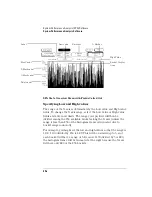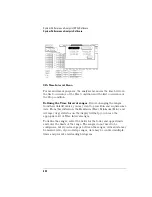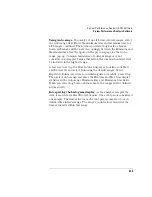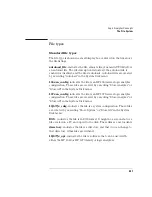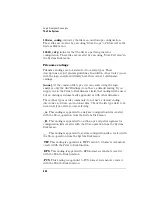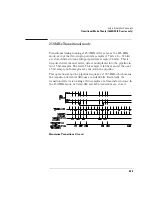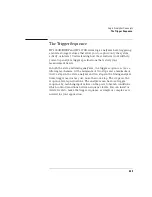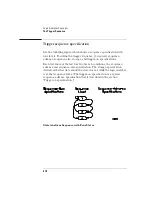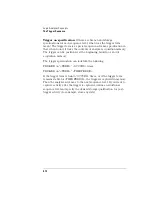
400
Logic Analyzer Concepts
The File System
Directories
Hard disk drive
When you receive the logic analyzer, the hard disk drive is already
DOS-formatted. The factory also creates a directory on the hard disk
drive named "/SYSTEM". The /SYSTEM directory is intended to store
system software such as backup copies of the operating system files
and the performance verification files. When you receive your logic
analyzer, the /SYSTEM directory already contains two X Window font
files and several files containing examples.
The files on the hard disk drive are not essential to the logic analyzer’s
correct operation. However, you can store important files such as
optional software, autoload files, configurations, and software backups
here. You can configure the logic analyzer to Autoload files from the
hard disk at power-up.
When the logic analyzer searches for autoload files and software
options, it first looks in the flexible disk drive. If the flexible disk drive
contains an autoload file and two software options, the analyzer does
not check the hard disk drive. If some of these were not found, the
analyzer next checks the hard drive’s /SYSTEM directory.
You can manually copy files, such as performance verification files, to
the /SYSTEM directory, but they will not necessarily be installed when
the analyzer powers up. To automatically load software, follow the
installation instructions provided with the software. It will change the
power-up sequence to include the software option and also copy the
files to the /SYSTEM directory.
Flexible disk drive
The flexible disk drive reads 3.5-inch flexible disks in both DOS and
LIF format. If a disk is in the drive when the analyzer is turned on, the
analyzer checks the disk for software and autoload files. If these files
are found, they are loaded into the analyzer.
Summary of Contents for 1670E Series
Page 6: ...6 In This Book...
Page 26: ...26 Contents...
Page 27: ...27 Section 1 Logic Analyzer...
Page 28: ...28...
Page 29: ...29 1 Logic Analyzer Overview...
Page 39: ...39 2 Connecting Peripherals...
Page 49: ...49 3 Using the Logic Analyzer...
Page 72: ...72 Using the Logic Analyzer The Inverse Assembler...
Page 73: ...73 4 Using the Trigger Menu...
Page 101: ...101 5 Using the Oscilloscope...
Page 151: ...151 6 Using the Pattern Generator...
Page 199: ...199 7 Triggering Examples...
Page 237: ...237 8 File Management...
Page 249: ...249 9 Logic Analyzer Reference...
Page 360: ...360 Logic Analyzer Reference The Compare Menu...
Page 361: ...361 10 System Performance Analysis SPA Software...
Page 397: ...397 11 Logic Analyzer Concepts...
Page 430: ...430 Logic Analyzer Concepts The Analyzer Hardware Oscilloscope board theory Oscilloscope board...
Page 439: ...439 12 Troubleshooting the Logic Analyzer...
Page 455: ...455 13 Specifications...
Page 471: ...471 14 Operator s Service...
Page 479: ...479 Operator s Service Troubleshooting Troubleshooting Flowchart 2...
Page 491: ...491 Section 2 LAN...
Page 492: ...492...
Page 493: ...493 15 Introducing the LAN Interface...
Page 497: ...497 16 Connecting and Configuring the LAN...
Page 506: ...506 Connecting and Configuring the LAN Connecting and Configuring the LAN...
Page 507: ...507 17 Accessing the Logic Analyzer File System Using the LAN...
Page 515: ...515 18 Using the LAN s X Window Interface...
Page 527: ...527 19 Retrieving and Restoring Data Using the LAN...
Page 539: ...539 20 Programming the Logic Analyzer Using the LAN...
Page 546: ...546 Programming the Logic Analyzer Using the LAN Programming the Logic Analyzer Using the LAN...
Page 547: ...547 21 LAN Concepts...
Page 555: ...555 22 Troubleshooting the LAN Connection...
Page 580: ...580 Troubleshooting the LAN Connection Getting Service Support...
Page 581: ...581 Section 3 Symbol Utility...
Page 582: ...582...
Page 583: ...583 23 Symbol Utility Introduction...
Page 588: ...588 Symbol Utility Introduction Symbol Utility Introduction...
Page 589: ...589 24 Getting Started with the Symbol Utility...
Page 597: ...597 25 Using the Symbol Utility...
Page 609: ...609 26 Symbol Utility Features and Functions...

